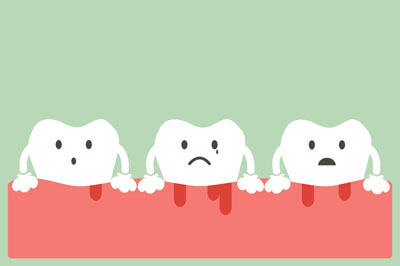 Anyone concerned about the health of their gums should visit a periodontist, a dental specialty that focuses on the health of the gum tissue and the bones underneath. It is important to note that while a general dentist can also treat gum disease, visiting someone who does so on a more frequent basis can be beneficial. Just like a family doctor can provide some initial diagnosis for a heart condition, a cardiologist will have better expertise in that area.
Anyone concerned about the health of their gums should visit a periodontist, a dental specialty that focuses on the health of the gum tissue and the bones underneath. It is important to note that while a general dentist can also treat gum disease, visiting someone who does so on a more frequent basis can be beneficial. Just like a family doctor can provide some initial diagnosis for a heart condition, a cardiologist will have better expertise in that area.
Visiting a periodontist is the best way to treat gum disease and to improve oral health. The two work together and are not exclusively independent, but as a team can provide the best dental care.
A family dentist will refer to a periodontist
The relationship between a family dentist and periodontist is a symbiotic one. A family dentist provides routine and general dental care. This is who a patient will visit twice a year to remove plaque and tartar from teeth, treating general issues like tooth decay. Patients who make these regular checkups may find that they never fully develop gum disease and are able to live with good oral health.
However, when gum disease develops beyond its initial stages, a family dentist will often refer to a periodontist for help. A family dentist only treats basic gum disease and does not treat more invasive procedures that are necessary for advanced stages of tooth decay. A family dentist will provide a cleaning and if this resolves the gum disease, then no treatment is required beyond this.
In most cases, if gum disease progresses, a general dental cleaning will not suffice. In this case, it is best to visit our clinic for a deep cleaning. We can remove the plaque and tartar from underneath the gum tissue. While a deep cleaning takes far longer than a typical general dental cleaning, it is necessary for removing what is irritating the gums.
Gum grafting
If gum disease has progressed to the point that the gums are receding and pulling away from the tooth structure, more significant treatment methods will be applied. For example, it may be necessary to have a gum grafting procedure. This is where tissue is grafted to the gums so that pockets can be closed and the gums can be secured back around the teeth.
The gums are there in part to protect the teeth so that they can remain in place and secure. A gum grafting procedure can be necessary to prevent tooth loss since loose teeth and eventual tooth loss are common when gum disease is left untreated. Since this is a surgical procedure, it is not something that most family dentists will handle, but is done by an experienced periodontist.
Schedule an appointment
If you have gum disease or are concerned that you do, call our office and schedule a consultation. We also take referrals from family dentists who would like to have a more experienced provider treat the advanced stages of gum disease.
Related Posts
The Impact of Periodontal Disease on Your Oral Health: What You Need to Know
Periodontal disease is a result of severe bacterial infection in the gum tissue. It causes many problems in the mouth. Knowing the impact of gum infection on your oral health can motivate …
When a Periodontist Evaluates the Health of Gums
When it comes to gum health, a periodontist is the right professional to see. Healthy gums are an integral part of your oral health and overall wellness. If you fail to take …
Gum Disease Prevention Tips from a Periodontist
A periodontist is a dentist who focuses on diagnosing and treating serious gum issues such as periodontitis. Also known as gum disease, this condition is preventable with some basic steps and good …
An Implant Periodontist Shares the Steps of Replacing Missing Teeth With Dental Implants
When missing or damaged teeth need to be replaced, a visit to an implant periodontist can restore uniformity and function in the mouth through dental implants. The process of replacing missing teeth …
